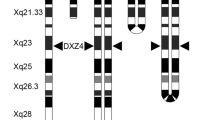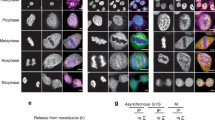Abstract
It has previously been shown that the acetylated forms of histone H4 are depleted or absent in both constitutive, centric heterochromatin and in the facultative heterochromatin of the inactive X chromosome (Xi) in female cells. By immunostaining of metaphase chromosomes from human lymphocytes with antibodies to the acetylated isoforms of histones H2A and H3, we now show that these histones too are underacetylated in both Xi and centric heterochromatin. Xi shows two prominent regions of residual H3 acetylation, one encompassing the pseudoautosomal region at the end of the short arm and one at about Xg22. Both these regions have been shown previously to be sites of residual H4 acetylation. H2A acetylation on Xi is higher overall than that of H3 or H4 and is particularly high around the pseudoautosomal region, but not at Xg22. The results suggest that the acetylated isoforms of H3 and H4 have at least some effects on chromosomal structure and function that are not shared by acetylated H2A.
Similar content being viewed by others
References
Braunstein M, Rose AB, Holmes SG, Allis CD, Broach JR (1993) Transcriptional silencing in yeast is associated with reduced nucleosome acetylation. Genes Dev 7: 592–604
Brockdorff N, Ashworth A, Kay G, McCabe V, Norris D, Cooper PJ, Swift S, Rastan S (1992) The product of the mouseXist gene is a 15kb inactive X-specific transcript containing no conserved ORF and located in the nucleus. Cell 71: 515–526
Brown CJ, LaFreniere RG, Powers VE, Sebastion G, Ballabio A, Pettigrew AL, Leadbetter DH, Levy E, Craig IW, Willard HF (1991) Localization of the X-inactivation center on the human X chromosome in Xg13. Nature 349: 82–84
Brown CJ, Hendrich BD, Rupert JL, LaFreniere RG, Xing Y, Lawrence J, Willard HF (1992) The human XIST gene: analysis of a 17kb inactive X-specific RNA that contains conserved repeats and is highly localised within the nucleus. Cell 71: 527–542
Davies KE, Mandel J-L, Monaco AP, Nussbaum RL, Willard HF (1991) Report of the committee on the genetic constitution of the X chromosome. (11th International Workshop on Human Gene Mapping) Cytogenet Cell Genet 58: 853–966
Disteche CM (1995) Escape from X inactivation in human and mouse. Trends Genet 11: 17–22
Grant SG, Chapman VM (1988) Mechanisms of X chromosome regulation. Annu Rev Genet 22: 199–233
Hnatowich DJ, Virzi F, Rusckowski M (1987) Investigations of avidin and biotin for imaging applications. J Nucl Med 28: 1294–1302
Jeppesen P, Turner BM (1993) The inactive-X chromosome in female mammals is distinguished by a lack of H4 acetylation, a cytogenetic marker for gene expression. Cell 74: 281–289
Jeppesen P, Mitchell A, Turner BM, Perry P (1992) Antibodies to defined histone epitopes reveal variations in chromatin conformation and underacetylation of centric heterochromatin in human metaphase chromosomes. Chromosoma 101: 322–332
Lee ACJ, Powell JE, Tregear GW, Niall HD, Stevens VC (1980) A method for preparing b-hCG COOH peptide carrier conjugates of predictable composition. Mol Immunol 17: 749–756
Migeon BM (1990) Insights into X-chromosome inactivation from studies of species variation, DNA methylation and replication and vice-versa. Genet Res 56: 91–98
Migeon BM (1994) X chromosome inactivation: molecular mechanisms and genetic consequences. Trends Genet 7: 230–235
Migeon BR, Luo S, Jani M, Jeppesen P (1994) The severe phenotype of females with tiny ring X chromosomes is associated with inability of these chromosomes to undergo X inactivation. Am J Hum Genet 55: 497–504
O'Neill LP, Turner BM (1995) Histone H4 acetylation distinguishes coding regions of the human genome from heterochromatin in a differentiation-dependent but transcription-independent manner. EMBO J 14: 3946–3957
Rastan S, Robertson EJ (1985) X chromosome deletions in embryo derived (EK) cell lines associated with the lack of X chromosome activation. J Embryol Exp Morphol 90: 379–388
Romeo G, Migeon BR (1970) Genetic inactivation of the α-galactosidase locus in carriers of Fabry's disease. Science 170: 180–181
Smeets D, Arets A (1990) Genetic determination of fragile site expression. Am J Hum Genet 47: 196–201
Sobel RE, Cook RG, Perry CA, Annunziato AT, Allis CD (1995) Conservation of deposition-related acetylation sites in newly synthesized histones H3 and H4. Proc Natl Acad Sci USA 92: 1237–1241
Takagi N, Sugawara O, Sasaki M (1982) Regional and temporal changes in the pattern of X-chromosome replication during the early postimplantation of the female mouse. Chromosoma 85: 275–286
Thompson JS, Ling X, Grunstein M (1994) The histone H3 amino terminus is required for both telomeric and silent mating locus repression in yeast. Nature 369: 245–247
Thorne AW, Kmiciek D, Mitchelson K, Sautière P, Crane-Robinson C (1990) Patterns of histone acetylation. Eur J Biochem 193:701–713
Turner BM (1993) Decoding the nucleosome. Cell 75: 5–8
Turner BM, Fellows G (1989) Specific antibodies reveal ordered and cell-cycle-related use of histone H4 acetylation sites in mammalian cells. Eur J Biochem 179: 131–139
Turner BM, O'Neill LP (1995) Histone acetylation in chromatin and chromosomes. Semin Cell Biol 6: 229–236
Turner BM, O'Neill LP, Allan IM (1989) Histone H4 acetylation in human cells. Frequency of acetylation at different sites defined by immunolabelling with site-specific antibodies. FEBS Lett 253: 141–145
Turner BM, Birley AJ, Lavender JS (1992) Histone H4 isoforms acetylated at specific lysine residues define individual chromosomes and chromatin domains in Drosophila polytene nuclei. Cell 69: 375–384
van Holde KE (1988) Chromatin. Springer, New York Berlin Heidelberg
Yoshida M, Kijima M, Akita M, Beppu T (1990) Potent and specific inhibition of mammalian histone deacetylase both in vivo and in vitro by trichostatin A J Biol Chem 256: 17174–17179
Author information
Authors and Affiliations
Corresponding author
Rights and permissions
About this article
Cite this article
Belyaev, N.D., Keohane, A.M. & Turner, B.M. Differential underacetylation of histones H2A, H3 and H4 on the inactive X chromosome in human female cells. Hum Genet 97, 573–578 (1996). https://doi.org/10.1007/BF02281863
Received:
Revised:
Issue Date:
DOI: https://doi.org/10.1007/BF02281863




